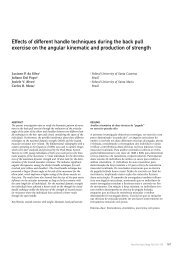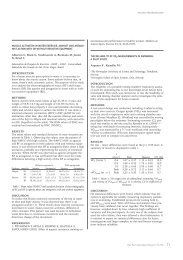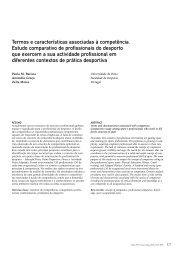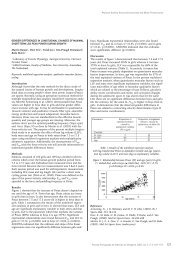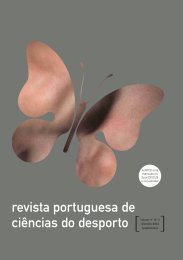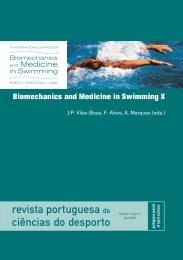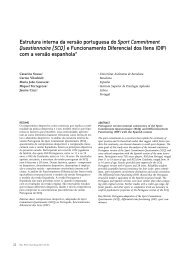adapted swimming sports and rehabilitation
adapted swimming sports and rehabilitation
adapted swimming sports and rehabilitation
You also want an ePaper? Increase the reach of your titles
YUMPU automatically turns print PDFs into web optimized ePapers that Google loves.
LOWER LIMB MUSCLES ACTIVITIES OF THE DEEP-WATER RUN-<br />
NING AND INTERVENTION EFFECTS ON BALANCE ABILITY IN THE<br />
ELDERLY<br />
Koichi Kaneda, Hitoshi Wakabayashi, Takeo Nomura<br />
University of Tsukuba, Ibaraki, Japan.<br />
This study was intended to investigate thigh-muscle activity<br />
during deep-water running (DWR) (Exp. 1), along with the<br />
effects of intervention with upright-floating (UF) exercise on<br />
balance ability in elderly (Exp. 2). Exp. 1: Nine healthy males<br />
(25.0 ± 0.5 yrs) performed DWR <strong>and</strong> water walking (WW).<br />
The surface electromyogram (EMG) electrodes were placed on<br />
the rectus femoris (RF) <strong>and</strong> biceps femoris (BF). The mean<br />
electromyogram (mEMG) of the BF during the DWR showed<br />
significantly higher values than that during the WW. Exp. 2:<br />
Fourteen healthy elderly persons (60.8 ± 5.3 yrs) participated<br />
in a once-a-week water exercise program of 12 weeks. They<br />
were separated into a normal <strong>and</strong> an UF group. The UF group<br />
improved the body-sway area (30 s, eyes open) <strong>and</strong> t<strong>and</strong>em<br />
walk time (10 steps). It was considered that the high stimulus<br />
of the BF during DWR affected the improvement of the balance<br />
ability in UF.<br />
Key Words: deep-water running, upright-floating, thigh muscles,<br />
EMG, balance ability, elderly.<br />
INTRODUCTION<br />
Various water exercises exist for <strong>rehabilitation</strong> or fitness maintenance.<br />
In water, buoyancy acts against the body to reduce the<br />
load at the joints, while water viscosity requires the subject to<br />
exert greater force than when moving on l<strong>and</strong> (3).<br />
An upright-floating situation in a water environment (feet separated<br />
from the <strong>swimming</strong> pool floor) is hard to experience in<br />
any other exercise environment. The typical form of uprightfloating<br />
(UF) exercise in water is deep-water running (DWR).<br />
The advantages of this exercise are that it reduces the impact<br />
stress for lower limb joints <strong>and</strong> maintains aerobic fitness (7).<br />
Studies have investigated motion analysis <strong>and</strong> aerobic fitness<br />
during DWR <strong>and</strong> suggested its characteristics. Moening et al.<br />
(4) described that when comparing DWR <strong>and</strong> treadmill running,<br />
the subject leans forward in the DWR at the trunk to<br />
counteract the buoyancy effect on the lower limbs. They also<br />
described that the DWR is an open kinetic chain compared to<br />
the closed kinetic chain of treadmill running. Another study of<br />
DWR reported that the maximal oxygen uptake ( V O2) <strong>and</strong><br />
the heart rate (HR) were lower than those for running on<br />
l<strong>and</strong>, but the ratings of perceived exertion (RPE; legs <strong>and</strong><br />
breathing) <strong>and</strong> the respiratory exchange ratio (RER) were<br />
greater during submaximal, whereas ventilation (l/min) was<br />
similar with younger males (10).<br />
However, no studies have investigated thigh muscle activity<br />
during DWR <strong>and</strong> its intervention effects for elderly persons.<br />
This study was intended to investigate lower limb muscle activity<br />
during DWR <strong>and</strong> the effects of intervention of UF exercise on<br />
balance abilities of elderly persons. We established two experiments<br />
to explore these issues mentioned above. The first experiment<br />
investigated thigh muscle activity during DWR in young<br />
males (Exp. 1). The second experiment conducted short-time<br />
water exercise intervention for elderly persons <strong>and</strong> investigated<br />
their balance ability before <strong>and</strong> after intervention (Exp. 2).<br />
·<br />
ADAPTED SWIMMING SPORTS AND REHABILITATION<br />
METHODS<br />
Exp. 1:<br />
Nine healthy young males participated in this experiment as<br />
subjects. Their respective mean age, height, weight <strong>and</strong> %fat<br />
were 24.9 ± 2.2 yrs, 172.0 ± 3.8 cm, 69.3 ± 3.7 kg, <strong>and</strong><br />
19.4 ± 4.1%. Informed consent was obtained for this experiment.<br />
Subjects practiced to familiarize themselves with water<br />
walking (WW) <strong>and</strong> DWR before the experiment. The subjects<br />
underwent WW <strong>and</strong> DWR at their comfortable speeds for 8 s<br />
with two repetitions. An aqua jogger (Aqua Jogger; Excel<br />
Sports Science Inc., Japan) was attached to the subject’s waist<br />
during DWR.<br />
The left thigh muscle activities of rectus femoris (RF) <strong>and</strong> biceps<br />
femoris (BF) were measured during trials using surface electromyography<br />
(EMG). The skin cuticle was removed carefully<br />
using a blood lancet (Blood Lancet; Asahi Polyslider Co. Ltd.,<br />
Japan) <strong>and</strong> cleaned with alcohol wipes so that the inter-electrode<br />
impedance was less than 20 kΩ. A pair of surface EMG electrodes<br />
(5 mm diameter) was placed in the middle of the belly of<br />
the RF <strong>and</strong> BF. Electrodes were covered with transparent film<br />
(Dressing tape No. 100; As One Corp., Japan) for waterproofing.<br />
The EMG signals were telemetered via a multi-channel telemetry<br />
system (WEB-5500 Nihon Kohden multi-telemeter system;<br />
Nihon Kohden Corp., Japan) using a time constant of 0.03 s,<br />
2 kHz sampling rate, <strong>and</strong> 500 Hz hi-cut filter.<br />
The trials were videotaped with synchronization to the EMG. A<br />
digital video camera was placed on the left side of the subject;<br />
it allowed coverage of one cycle at a 30 Hz frame rate. Data<br />
were collected from one cycle of the videotaped picture, from<br />
heel contact to the next heel contact in WW <strong>and</strong> from the maximum<br />
knee drive (as a maximal hip flexion) to the next maximum<br />
knee drive at DWR. Then, the mean electromyogram<br />
(mEMG) was calculated during one cycle. The water temperature<br />
was set at 27 ± 2°C <strong>and</strong> the water depth was set at 1.1 m<br />
throughout the experiment.<br />
Paired Student’s t-tests were used to compare differences<br />
between WW <strong>and</strong> DWR. Statistical significance was inferred at<br />
p < 0.05.<br />
Exp. 2:<br />
Fourteen healthy elderly volunteers (mean age 60.9 ± 5.3 yrs.:<br />
2 males <strong>and</strong> 12 females) were separated into two groups: a<br />
normal water exercise group (NW, n = 7: 1 male <strong>and</strong> 6<br />
females) <strong>and</strong> an upright-floating exercise group (UF, n = 7: 1<br />
male <strong>and</strong> 6 females). Their mean height, weight <strong>and</strong> BMI were<br />
respectively 150.9 ± 6.6 cm, 56.2 ± 10.9 kg <strong>and</strong> 24.5 ±3.2 in<br />
NW, 153.2 ± 8.6 cm, 61.3 ± 7.3 kg <strong>and</strong> 26.1 ± 2.0 in UF. They<br />
had already become accustomed to water exercise, but did not<br />
engage in other water exercise programs. Informed consent<br />
was obtained for this experiment program. Subjects participated<br />
in a 60 min water exercise program, including 30 min divided<br />
into two groups in one session, once a week, for 12 weeks.<br />
The NW participants underwent WW, resistance training <strong>and</strong><br />
other ordinary water exercises using a kick board (Fig. 1A).<br />
The UF participants performed locomotive motions, mainly<br />
DWR with feet separate from the bottom of the <strong>swimming</strong><br />
pool, using a water noodle (Fig. 1B). The pool depth was<br />
1.1–1.3 m; it was 25.0 m long <strong>and</strong> 3.6 m wide, with water temperature<br />
maintained at 30°C throughout the 12 weeks. A bodysway<br />
test for static balance ability (12) <strong>and</strong> a t<strong>and</strong>em walk test<br />
for dynamic balance ability (2) were conducted before <strong>and</strong> after<br />
12 weeks. The body-sway test was conducted using a posturo-<br />
Rev Port Cien Desp 6(Supl.2) 351-357 351
352<br />
ADAPTED SWIMMING SPORTS AND REHABILITATION<br />
graphic meter (Gravicoda GS-10, type-C; Anima Co., Japan).<br />
Subjects stood silently on the posturographic meter staring at a<br />
point marked on the wall (distance was 3 m forward, height<br />
was 1.5 m) with their feet bared <strong>and</strong> kept together. Tests were<br />
conducted for 30 s with eyes open. Body-sway distance <strong>and</strong><br />
body-sway area were analyzed in this study. A t<strong>and</strong>em walk<br />
test was conducted for two trials. Subjects were required to<br />
walk heel to toe along a 10-step line as quickly as they could<br />
without mis-stepping. A misstep occurred when subjects<br />
stepped completely off the line or failed to follow a heel-to-toe<br />
pattern. The 10-step t<strong>and</strong>em walk time measured using a stopwatch<br />
of two trials without mis-stepping was then averaged.<br />
Wilcoxon’s signed-rank test was used to detect differences in<br />
the two tests taken by each group for the conditions before <strong>and</strong><br />
after 12 weeks. A Mann-Whitney U-test was used to assess differences<br />
in two tests between two groups before <strong>and</strong> after 12<br />
weeks. The statistically significant level was set as p < 0.05.<br />
Figure 1. Typical exercise forms of respective groups.<br />
RESULTS<br />
Exp. 1:<br />
Figure 2 shows the mean ± SD values of the time for 1 cycle in<br />
each trial. The time for 1 cycle was 2.45 ± 0.23 s for WW <strong>and</strong><br />
1.51 ± 0.27 s for DWR. A significant difference in the 1 cycle<br />
time was found between WW <strong>and</strong> DWR (p < 0.05). Figure 3<br />
shows mean ± SD values of the mEMG of RF <strong>and</strong> BF. The<br />
mEMG values of RF were 9.90 ± 2.96 µV in WW <strong>and</strong> 8.20 ±<br />
2.81 µV in DWR. The mEMG values of BF were 11.46 ± 3.39 µV<br />
in WW <strong>and</strong> 22.85 ± 14.06 µV in DWR. The mEMG value of BF<br />
during DWR was significantly higher (p < 0.05) than that during<br />
WW, but no difference was apparent in the mEMG value of RF.<br />
Exp. 2:<br />
The mean ± SD values of body-sway <strong>and</strong> t<strong>and</strong>em walk tests at<br />
baseline <strong>and</strong> after 12 weeks are shown in Table 1. The values of<br />
body-sway distance were 45.70 ± 14.54 cm in NW <strong>and</strong><br />
46.54 ± 11.28 cm in UF at baseline, 53.97 ± 21.19 cm in NW<br />
<strong>and</strong> 42.80 ± 7.74 cm in UF at after 12 weeks. A significant<br />
increase of the body-sway distance was apparent in NW (p <<br />
0.05). In the body-sway area, the values were 1.94 ± 1.23 cm 2<br />
in NW <strong>and</strong> 2.59 ± 1.28 cm 2 in UF at baseline, 2.96 ± 2.06 cm 2<br />
in NW <strong>and</strong> 1.91 ± 0.62 cm 2 in UF at after 12 weeks. The tendency<br />
of the body-sway area was apparent in each group, but<br />
increasing in NW (p = 0.06) <strong>and</strong> decreasing in UF (p = 0.09).<br />
The t<strong>and</strong>em walk times were 7.3 ± 1.4 s in NW <strong>and</strong> 7.4 ± 1.1<br />
s in UF at baseline, 6.9 ± 1.1 s in NW <strong>and</strong> 6.6 ± 0.8 s in UF at<br />
after 12 weeks, respectively. A significant decrease of the t<strong>and</strong>em<br />
walk time was detected in UF (p < 0.05).<br />
Rev Port Cien Desp 6(Supl.2) 351-357<br />
DISCUSSION<br />
The first objective of this study was to compare the thigh<br />
muscle activities of WW <strong>and</strong> DWR. For that purpose, the first<br />
experiment was designed to collect the RF <strong>and</strong> BF activity<br />
data using surface EMG <strong>and</strong> mEMG during 1 cycle at each<br />
trial <strong>and</strong> compare them. The mEMG of BF was significantly<br />
higher in DWR than that of WW (p = 0.05), but the mEMG<br />
of RF was similar.<br />
No studies have compared WW to DWR directly in motion<br />
analysis. Moening et al. (4) described that trunk flexion was<br />
larger for DWR than for treadmill running on l<strong>and</strong>. In addition,<br />
the joint angle of hip maximum flexion in the knee drive was<br />
about 60° greater in DWR than that in treadmill running. At<br />
the knee joint, the range of motion from the back swing to the<br />
knee drive was about 55° greater in DWR than that in treadmill<br />
running. Hip <strong>and</strong> knee flexion are greater in DWR than<br />
that in treadmill running. Miyoshi et al. (3) reported that the<br />
range of motion at the hip joint in WW was similar to l<strong>and</strong><br />
walking at comfortable speed, <strong>and</strong> that the range of motion at<br />
the knee joint in WW was smaller than that of l<strong>and</strong> walking.<br />
Regarding treadmill walking <strong>and</strong> running, Nilsson et al. (6)<br />
reported that the net hip angle was somewhat larger during<br />
walking than running at the same speed. The net amplitude of<br />
the hip joint was four times larger during running than walking<br />
when the speed was changed from low to high. They also<br />
reported a significantly larger net knee flexion amplitude during<br />
running than during walking.<br />
This study measured the RF <strong>and</strong> BF muscle activities <strong>and</strong> compared<br />
WW to DWR. The RF activates hip flexion <strong>and</strong> knee<br />
extension. The BF activates hip extension <strong>and</strong> knee flexion. We<br />
hypothesized that muscle activities of RF <strong>and</strong> BF were higher<br />
in DWR than in WW, but this study showed a similar value on<br />
RF activity, probably because buoyancy served to assist hip<br />
flexion, although maximum flexion in the knee drive was<br />
greater in DWR than in WW. The higher muscle activity of BF
in DWR than in WW was attributable to the greater range of<br />
motion at the knee joint in DWR. Experiments of motion<br />
analysis that are synchronized to EMG are required to elucidate<br />
this aspect more precisely.<br />
The second objective of this study was investigation of the<br />
intervention effects of UF exercise on balance ability in elderly.<br />
For that purpose, we designed a once-a-week water exercise<br />
program lasting 12 weeks <strong>and</strong> established NW <strong>and</strong> UF exercise<br />
groups. The body-sway distance <strong>and</strong> area were increased in<br />
NW, but the body-sway area was decreased in UF <strong>and</strong> the t<strong>and</strong>em<br />
walk time of 10 steps was decreased in UF.<br />
It is widely acknowledged that body-sway as a static balance<br />
ability reflects the center of gravity (COG) during st<strong>and</strong>ing (5).<br />
T<strong>and</strong>em walking is often used as a dynamic balance ability (2).<br />
In the present study, the static balance declined in NW, but<br />
static <strong>and</strong> dynamic balance improved in UF. No studies have<br />
reported the decline of body-sway through exercising for the<br />
elderly. Simmons et al. (8), who reported enhancement of functional<br />
reach in water exercise group, explained two characteristics<br />
during water exercise. First, the buoyancy provided by<br />
water can be considered destabilizing because it will tend to lift<br />
a subject up. Second, because water exercise was conducted for<br />
a group, this created turbulence, which might have increased<br />
the variability of the factors influencing each participant’s<br />
movement. Destabilizing buoyancy <strong>and</strong> turbulence that<br />
occurred during water exercise might have affected the<br />
increased body-sway distance <strong>and</strong> area in NW.<br />
Improvement of body-sway in women with lower extremity<br />
arthritis was demonstrated in water exercises (9). In the present<br />
study, UF improved the body-sway area. T<strong>and</strong>em walking also<br />
improved only the UF group. Experiment 1 revealed that BF<br />
mEMG increased significantly in DWR compared to WW. The<br />
high stimulus of the BF during DWR was inferred to improve<br />
the balance ability in UF. Other possibilities are coordination<br />
between the legs <strong>and</strong> body or adjustment of body balance, as<br />
seen in Tai Chi Chuan (1), but further research is required.<br />
The static <strong>and</strong> dynamic balance ability improved in UF in the<br />
present study. In general, the balance ability declines with age;<br />
it is an important function that prevents fall accidents because<br />
it is associated with postural control (11). Results of the present<br />
study suggest that UF exercise might be useful for elderly<br />
persons to prevent fall accidents because the balance ability<br />
was improved after 12 weeks’ intervention.<br />
CONCLUSION<br />
This study suggests that UF exercise can improve the balance<br />
abilities of elderly persons. It might be affected by the high<br />
muscle activity of BF during DWR. Furthermore, because balance<br />
abilities were improved after 12 weeks, UF exercise in the<br />
water might be useful to prevent elderly persons’ fall accidents.<br />
ACKNOWLEDGEMENTS<br />
Support of the staff of the Swim Laboratory at the University<br />
of Tsukuba is greatly appreciated. We also thank all 9 young<br />
men of Exp. 1 <strong>and</strong> 14 elderly men <strong>and</strong> women of Exp. 2 for<br />
participating enthusiastically in this study.<br />
REFERENCES<br />
1. Jin C, Watanabe K (2003). The practice of Tai Chi Chuan in<br />
middle <strong>and</strong> elderly person <strong>and</strong> its effect to static <strong>and</strong> dynamic<br />
postural stability. Jpn J Phys Fitness Sports Med, 52: 369-80, in<br />
Japanese<br />
ADAPTED SWIMMING SPORTS AND REHABILITATION<br />
2. Medell JL, Alex<strong>and</strong>er NB (2000). A clinical measure of maximal<br />
<strong>and</strong> rapid stepping in older women. Journal of<br />
Gerontology: Medical Sciences, 55A(8): M429-33<br />
3. Miyoshi T, Shirota T, Yamamoto S, Nakazawa K, Akai M<br />
(2004). Effect of the walking speed to the lower limb joint<br />
angular displacements, joint moments <strong>and</strong> ground reaction<br />
forces during walking in water. Disability <strong>and</strong> Rehabilitation,<br />
26(12): 724-32<br />
4. Moening D, Scheidt A, Shepardson L, Davies GJ (1993).<br />
Biomechanical comparison of water running <strong>and</strong> treadmill running.<br />
Isokinetics <strong>and</strong> Exercise Science, 3(4): 207-15<br />
5. Murray MP, Seireg A, Scholz RC (1967). Center of gravity,<br />
center of pressure, <strong>and</strong> supportive forces during human activities.<br />
J Appl Physiol, 23(6): 831-8<br />
6. Nilsson J, Thorstensson A, Halbertsma J (1985). Changes in<br />
leg movements <strong>and</strong> muscle activity with speed of locomotion<br />
<strong>and</strong> mode of progression in humans. Acta Physiol Sc<strong>and</strong>, 123:<br />
457-75<br />
7. Reilly T, Dowzer CN, Cable NT (2003). The physiology of<br />
deep-water running. Journal of Sports Sciences, 21: 959-72<br />
8. Simmons V, Hansen PD (1996). Effectiveness of water exercise<br />
on postural mobility in the well elderly: An experimental<br />
study on balance enhancement. Journal of Gerontology:<br />
Medical Sciences, 51A(5): M233-8<br />
9. Suomi R, Koceja DM (2000). Postural sway characteristics in<br />
women with lower extremity arthritis before <strong>and</strong> after an<br />
aquatic exercise intervention. Arch Phys Med Rehabil, 81: 780-<br />
5<br />
10. Svedenhag J, Seger J (1992). Running on l<strong>and</strong> <strong>and</strong> in water:<br />
comparative exercise physiology. Med Sci Sports Exerc, 24(10):<br />
1155-60<br />
11. Woollacott M (1993). Age-related changes in posture <strong>and</strong><br />
movement. The Journal of Gerontology, 48: 56-60<br />
12. Yoneda T, Muraki T, Taketomi Y (1994). Influence of aging<br />
on st<strong>and</strong>ing balance. Bulletin of Allied Medical Sciences, Kobe<br />
10: 61-68.<br />
DURATION OF ONE UNIT (80KCAL) DURING TREADMILL WALKING<br />
IN WATER<br />
Kumiko Ono1 , Kazuki Nishimura1 , Sho Onodera2 1Graduate School, Kawasaki University of Medical Welfare, Kurashiki,<br />
Japan<br />
2Kawasaki University of Medical Welfare, Kurashiki, Japan.<br />
The number of Japanese people diagnosed with diabetes has<br />
been increasing. Epidemiological <strong>and</strong> intervention studies of<br />
endurance exercise training strongly support its efficacy for<br />
improving diabetes. The purpose of the present study was to<br />
make clear the difference of duration per expended one unit<br />
(80kcal) during treadmill walking in water between younger<br />
<strong>and</strong> older people. We would get the st<strong>and</strong>ard data by using non<br />
diabetes people. Ten healthy young men <strong>and</strong> eight healthy<br />
women participated in this study. Subjects walked at 1, 2 <strong>and</strong><br />
3km/h (30.3°C). The duration of exercise that expended one<br />
unit of energy was calculated from VO 2. Younger <strong>and</strong> older<br />
people’s calculated results were 41’39’’ <strong>and</strong> 39’44’’ (1km/h),<br />
33’22’’ <strong>and</strong> 31’56’’ (2km/h) <strong>and</strong> 24’51’’ <strong>and</strong> 24’56’’ (3km/h).<br />
There was no difference due to the difference of the age in one<br />
unit. It might be suggested that it becomes possible to pre-<br />
Rev Port Cien Desp 6(Supl.2) 351-357 353
354<br />
ADAPTED SWIMMING SPORTS AND REHABILITATION<br />
scribe underwater exercise for older diabetes patients by using<br />
the young’s one unit index.<br />
Key Words: treadmill, walking water, one unit (80kcal), diabetes.<br />
INTRODUCTION<br />
It is believed that in Japan 7.4 million people are suspected of<br />
having diabetes (2002). Moreover, recently the number of<br />
Japanese people diagnosed with diabetes has been increasing.<br />
Many diabetes patients suffer from complications, for example<br />
diabetic renal disease, retinopathy <strong>and</strong> neurosis. As for diabetic<br />
renal disease, it is the NO. 1 cause of artificial dialysis in Japan.<br />
Many diabetes patients also suffer from obesity.<br />
Epidemiological <strong>and</strong> intervention studies of endurance exercise<br />
training strongly support its efficacy for improving diabetes.<br />
But exercise on l<strong>and</strong> causes kidney blood flow to reduce. It will<br />
not be good for it’s patient’s kidney. In water, the amount of<br />
kidney blood flow is maintained during exercise. And by the<br />
action of buoyancy the weight which is loaded on the joint of<br />
the legs decreases.<br />
The remedy for diabetes consists of diet, exercise <strong>and</strong> medication.<br />
For diet, the unit conversion which designates 80kcal as<br />
one unit has been used in Japan. For diabetes patients, by using<br />
this kind of unit conversion, they can take the calorie which is<br />
easily decided in detail (intake per a day divided by nutrition).<br />
So far we calculated the duration when one unit (80kcal) is<br />
expended in young people during underwater treadmill walking.<br />
As for diabetes, it can recognize the increase of morbidity<br />
in older people. The purpose of the present study was to make<br />
clear the difference of duration per expended one unit (80kcal)<br />
between younger <strong>and</strong> older people during treadmill walking in<br />
water, <strong>and</strong> whether or not one unit index of the young can be<br />
<strong>adapted</strong> to older.<br />
METHODS<br />
In this study, in order to accomplish the above mentioned purpose,<br />
we gathered st<strong>and</strong>ard data which is intended for people<br />
who are not diabetes as the subject. Ten healthy young men<br />
(age: 22.6±1.1 yrs, height: 171.6±5.4 cm, weight: 67.7±8.4 kg<br />
<strong>and</strong> %fat: 19.2±4.7 %) <strong>and</strong> eight healthy women (age:<br />
61.8±4.3 yrs, height: 152.4±3.9 cm, weight: 60.0±4.9 kg <strong>and</strong><br />
%fat: 34.1±2.8 %) participated in this study. We conducted<br />
informed consent following the Helsinki declaration for participation<br />
in this experiment.<br />
In order to enter the water, subjects wore a <strong>swimming</strong> suit.<br />
They took a rest by st<strong>and</strong>ing before walking for 5 minutes each<br />
on l<strong>and</strong> <strong>and</strong> then in water. Subjects walked at 3 velocities (1, 2<br />
<strong>and</strong> 3km/h) on a treadmill in water. On the 1 st day, young subjects<br />
were walking in water for 15 minutes at one velocity.<br />
They walked the other two velocities other day. On the other<br />
h<strong>and</strong>, older subjects completed three consecutive 7-minute<br />
walks at progressively increasing velocity. So they walked for<br />
21 minutes in water. Water level was set to Trochanter major.<br />
Heart rate (HR) <strong>and</strong> oxygen uptake (VO 2) were measured. HR<br />
was measured by bipolar lead chronologically. And we recorded<br />
for each minute. Exhaled gas was gathered to calculate VO 2.<br />
We set 5 points to gather. It’s rest on l<strong>and</strong> for 5 minutes, rest<br />
in water for five minutes <strong>and</strong> walking in water for 2 minutes by<br />
each velocity. The duration of exercise that expended one unit<br />
of energy was calculated from oxygen uptake. Energy used per<br />
liter of expended oxygen is about 5 kcal, so we used the following<br />
formula (duration of one unit=16/VO 2).<br />
Rev Port Cien Desp 6(Supl.2) 351-357<br />
Water temperature, room temperature <strong>and</strong> humidity during the<br />
experiments were 30.3±0.3°C, 26.9±0.7°C <strong>and</strong> 76.6±2.3%.<br />
RESULTS<br />
The young’s average HR at rest was 72.2±8.6 bpm on l<strong>and</strong> <strong>and</strong><br />
64.3±8.2 bpm in water. Older people’s average HR at rest was<br />
81.2 ±10.4 bpm on l<strong>and</strong> <strong>and</strong> 76.2±9.3 bpm in water. Average<br />
HR for older people was significantly higher than the young’s<br />
on l<strong>and</strong> <strong>and</strong> in water respectively (p
Table 1. The Duration of Expending One Unit (80kcal) during<br />
Treadmill Walking in Water.<br />
velocity (km/h) young subjects (min) Olderly subjects (min)<br />
1 41.66±4.56 (41’39’’) 39.73±6.54 (39’44’’)<br />
2 33.37±4.59 (33’22’’) 31.94±4.49 (31’56’’)<br />
3 24.86±5.23 (24’51’’) 24.93±4.18 (24’56’’)<br />
DISCUSSION<br />
It was made clear that older people’s HR on l<strong>and</strong> at rest was<br />
higher, the rate of decease in HR in water at rest was lower <strong>and</strong><br />
the rate of increase in HR while exercising was higher than the<br />
young’s. From this, it was suggested that older people’s Venous<br />
Return could prevent promotion by comparison with the young.<br />
The aerobic ability of older people has decreased by comparison<br />
with the young. As a result, we thought that older people’s<br />
absolute VO 2 became the same as the young’s. So we could<br />
have to consider the duration of exercise for the patient whose<br />
body weight deviates from these subjects. For example, if<br />
patient’s weight is too high when compared with the young<br />
subjects’ we should change the duration by decreasing it.<br />
When introducing exercise we should start at lower durations,<br />
too. The Ministry of Health, Labour <strong>and</strong> Welfare in Japan<br />
advises that diabetes patients should exercise enough to sweat<br />
a little while having a conversation with their neighbor easily<br />
for about 30 minutes per day. So we could say that our index is<br />
fit for these patients.<br />
As said in the introduction it is clear that exercise on l<strong>and</strong><br />
reduces the renal blood flow rate but that in water it is maintained.<br />
By exercising on l<strong>and</strong> or in water our muscles can use<br />
glucose easily <strong>and</strong> glucose metabolism is improved; so they<br />
should exercise. Including diabetes patients that may develop<br />
diabetic renal disease, we could say that for diabetes patients<br />
exercise in water is the best choice of training for preventing<br />
deterioration of diabetes.<br />
Almost all Japanese people live on rice. The energy of a half<br />
cup of rice is about 80 kcal. So, in the diet of diabetics in<br />
Japan, the unit conversion which designates 80 kcal as one unit<br />
has been used. It suggests that the index calculated in this<br />
study is useful for the patients exercising by themselves, too.<br />
We calculated the duration of water level that is at Processus<br />
xiphoideus, too. The results were 62’41’’ (1km/h), 50’33’’<br />
(2km/h) <strong>and</strong> 37’51’’ (3km/h). If the water level goes up to the<br />
Processus xiphoideus, the duration for expending one unit<br />
becomes long. It is showed that the strength of the exercise is<br />
lower than at Trochanter major. So introducing exercise for the<br />
patients we should start at the Processus xiphoideus level.<br />
CONCLUSION<br />
In this study we calculated the duration of expending one unit<br />
(80kcal) of energy during treadmill walking in water to obtain<br />
the st<strong>and</strong>ard data to improve diabetes. Older people’s one unit<br />
data was equal to the young’s. We could expect to prevent the<br />
health of those with aggravation of diabetes or improve it using<br />
the one unit index. Using this index, we can connect it to the<br />
QOL maintenance or the improvement of life for patients with<br />
diabetes patients who also are at an advanced age.<br />
ACKNOWLEDGEMENTS<br />
For his assistance with the study the authors would like to<br />
thank Michael J. Kremenik, an associate professor at the<br />
Kawasaki University of Medical Welfare, Kurashiki.<br />
ADAPTED SWIMMING SPORTS AND REHABILITATION<br />
REFERENCES<br />
1. Ono K, Ito M, Kawaoka T, Kawano H, Shiba D, Seno N,<br />
Terawaki F, Nakajima M, Nishimura K, Onodera S (2005).<br />
Changes in heart rate, rectal temperature <strong>and</strong> oxygen uptake<br />
during treadmill walking in water <strong>and</strong> walking in a pool.<br />
Journal of Kawasaki Medical Welfare Society 14: 323-330.<br />
2. Hung CT (1989). Food exchange list based on 80-kilocalorie<br />
rice unit. Taiwan yi xue hui za zhi. Journal of the Formosan<br />
Medical Association, 88: 595-600.<br />
3. Ministry of Health, Labour <strong>and</strong> Welfare (2005). Dietary<br />
Reference Intakes for Japanese. Tokyo. Japan: Dai-ichi Syuppan<br />
Publishing Co. LTD.<br />
MOVEMENT ANALYSIS IN CAD-PATIENTS<br />
Lutz Schega1,2 , Daniel Daly2 1Otto-von-Guericke-University Magdeburg, Institute of Sport Science,<br />
Germany<br />
2K.U. Leuven, Department of Rehabilitation Sciences, Belgium.<br />
Changes in movement parameters under various load conditions<br />
during breaststroke <strong>swimming</strong> were assessed in Coronary<br />
Artery Disease (CAD) patients. Kinematic analysis of time-discrete<br />
<strong>and</strong> time-continuous characteristics, <strong>and</strong> timing of the<br />
swim-movement was made during a breaststroke “load-steptest”<br />
in a flume for 26 male CAD-patients. Factor analysis was<br />
applied. The path of h<strong>and</strong>s, feet <strong>and</strong> hips, the pause between<br />
propulsive phases <strong>and</strong> the angle of attack of hip-shoulder-water<br />
surface are of crucial importance in patients with CAD. These<br />
findings are supported by the factor analysis where comparable<br />
parameters were found to be of relevance. Results did indicate<br />
large individual variations in time-continues characteristics.<br />
Key Words: <strong>swimming</strong>, <strong>rehabilitation</strong>, biomechanics, coronary<br />
artery disease.<br />
INTRODUCTION<br />
The importance of physical activity in patients with Coronary<br />
Artery Disease (CAD) is undisputable. The aim of sport related<br />
<strong>rehabilitation</strong> is to develop an optimal specific program depending<br />
on the current condition of the individual. Nevertheless<br />
such programs focus primarily on physiological adaptations<br />
although it is well known that changes in the movement may<br />
influence this. The physiological adaptation to immersion in<br />
various water temperatures <strong>and</strong> the duration of immersion have<br />
often been investigated in this population (e.g. 1,2). Few scientific<br />
reports (5, 8), however, provide information on the actual<br />
<strong>swimming</strong> movement in patients with cardiac disease. Some<br />
studies have provided indications of the influence of movement<br />
changes on physiological responses from a qualitatively point of<br />
view, for example by Bücking et al. (2) <strong>and</strong> Meyer & Bücking<br />
(9). No quantitatively analysis has been reported however. The<br />
goal of this study, therefore, was to assess the changes in movement<br />
parameters of CAD patients under different load conditions<br />
during breaststroke <strong>swimming</strong>.<br />
METHODS<br />
Two-dimensional movement analysis (SIMI-Motion) was made<br />
during a flume “load-step-test” in breaststroke of 26 male<br />
CAD-patients: age, 59yrs. (± 8.2), infarct age, 8yrs. (± 6.8),<br />
Rev Port Cien Desp 6(Supl.2) 351-357 355
356<br />
ADAPTED SWIMMING SPORTS AND REHABILITATION<br />
height, 178.3cm, (SD= 8.4), weight, 78.5kg (± 11.4), body<br />
surface, 2.1m 2 (± 0.24). The test consisted of three 3 minute<br />
swims at the same mean <strong>swimming</strong> speed with added, subtracted<br />
or no extra load.<br />
One S-VHS video camera was placed outside the flume perpendicular<br />
to the <strong>swimming</strong> direction at 3.5-m from the swimmer.<br />
The actual camera view in the <strong>swimming</strong> plane was 4-m<br />
x 3-m. At the start of each video session a 1-m calibration<br />
ruler was placed in both the vertical <strong>and</strong> horizontal direction<br />
<strong>and</strong> recorded. Reference makers were set at eight points on<br />
the left side of the body: toe, ankle, knee, hip, shoulder, elbow,<br />
wrist <strong>and</strong> top middle finger. Recordings were made during<br />
each step, in order to analyse 10 movement cycles in the middle<br />
of each step. Sampling frequency was 50 Hz. Digitizing<br />
was done using the SIMI-Motion “ software package 6.1 <strong>and</strong><br />
analysis was based on the breaststroke phase model of<br />
Wieg<strong>and</strong> et al. (12) (Figure 1).<br />
Figure 1. Breaststroke Phase-Model by Jähnig et al. (7).<br />
To describe the complex movement, time-discrete (paths, durations,<br />
velocities, angles) <strong>and</strong> time-continuous characteristics<br />
(v x-t-progress of the hip depend on arm <strong>and</strong> leg by Federle<br />
(4)), <strong>and</strong> timing of the swim-movement (Phase Structure<br />
Quotient-PSQ of Blaser et al. (1)) were examined. All in all 57<br />
movement-parameters were determined in 3 <strong>swimming</strong> situations<br />
in each patient. Means <strong>and</strong> st<strong>and</strong>ard deviations were<br />
determined. Significant changes of parameters over 10 movement<br />
cycles between load steps were calculated using the nonparametric<br />
Wilcoxon-test. The level of significance was set at P<br />
< 0.05. A factor analysis (principle –component analysis) was<br />
performed as described by Hotelling (6) <strong>and</strong> Kelly (7). Phase<br />
structure quotient for both arm <strong>and</strong> leg movements were determined<br />
as follows:<br />
PSQ = (duration of main phase/ duration of initiation phase<br />
+ duration of linking phase + duration of preparation phase)<br />
x 100%(1).<br />
RESULTS<br />
Based on the time-discrete findings 9 parameters were found to<br />
be relevant to describe the changes in <strong>swimming</strong> movement of<br />
the CAD-patients examined. These 9 parameters showed a frequency<br />
of change of more than 5 (Table 1). All in all only one<br />
patient demonstrated no significant changes over the increasing<br />
load steps. On average 31 (±14) parameters changed.<br />
Rev Port Cien Desp 6(Supl.2) 351-357<br />
Table 1. Frequency <strong>and</strong> Characteristic of time-discrete kinematic<br />
parameters during <strong>swimming</strong>.<br />
Frequency<br />
Parameter ≥ 5 Characteristic<br />
Vertical path of h<strong>and</strong> in main phase of arm 8 1 x s; 1 x f ; 5 x d (^);<br />
1 x d (v)<br />
Vertical path of foot in main phase of leg 7 2 x s; 1 x d (^); 4 x d (v)<br />
Resultant path of h<strong>and</strong> in main phase of arm 6 2 x s; 2 x d (^); 2 x d (v)<br />
Horizontal path of h<strong>and</strong> in main phase of arm 6 2 x s; 3 x d (^); 1 x d (v)<br />
Horizontal path of h<strong>and</strong> during arm stroke 5 1 x s; 3 x d (^); 1 x d (v)<br />
Horizontal path of hip during leg stroke 5 2 x f; 1 x d (^); 2 x d (v)<br />
Duration of propulsion-pause between main<br />
phase of arm <strong>and</strong> main phase of leg 8 2 x s; 2 x d (^); 4 x d (v)<br />
Duration of propulsion-pause between main<br />
phase of leg <strong>and</strong> main phase of arm 7 2 x f; 5 x d (^)<br />
Angle of attack of hip-shoulder-water surface 5 1 x f; 4 x d (^)<br />
Legend: s-increasing, f-decreasing, d-discontinuous (^)=direction<br />
From the time-continuous point of view individual time series<br />
patterns were observed in arm <strong>and</strong> leg movements. Figure 2<br />
shows examples of an arm-swimmer (left) <strong>and</strong> leg-swimmer<br />
(right). It was also possible to distinguish so called “changeswimmers”<br />
(4) with differing propulsion of the arms <strong>and</strong> legs.<br />
Only one patient actually demonstrated an ideal velocity-timeregime<br />
of the hip according to Costill et al. (3) or Schramm<br />
(10). In total a marked divergent regime in horizontal hipvelocity<br />
was observed in this population: 12 arm-swimmers, 4<br />
leg-swimmers <strong>and</strong> 10 change-swimmers.<br />
The calculated PSQ describes some problems of these patients to<br />
react to increased load conditions. Six patients showed significant<br />
changes of PSQ of the arms. The other 20 patients did not<br />
change time-continuous characteristics with increasing loads.<br />
The calculated PSQ-values of the legs changed significantly in 10<br />
patients whereas 16 patients showed no adaptation during the<br />
step-test. As an example figure 3 shows the inter-individual<br />
adaptation of the development of PSQ of the arms <strong>and</strong> legs.<br />
Figure 2. Breaststroke arm-swimmer (left) <strong>and</strong> leg-swimmer (right).<br />
Figure 3. Two examples of the development of PSQ of the arm (PSQ A)<br />
<strong>and</strong> leg (PSQ B). Significant differences between load steps (*p ≤ .05,<br />
**p ≤ .01) are indicated.
As a result of factor analysis 4 factor-components of relevance<br />
provide indications for organizing swim <strong>rehabilitation</strong> programs<br />
with a special view to movement co-ordination. Table 2<br />
gives on overview of the specific movement parameters of each<br />
relevant factor-component. The variance of the factor-components<br />
are: 30% for time-structure, 18% for velocity-regime,<br />
10% posture of upper part of the body, 8% for angle of attack<br />
of thigh. The verification of reliability of the factors showned<br />
good internal consistencies (Cronbachs Alpha from .62 to .89).<br />
All main items may be evaluated as strong to very strong<br />
regarding selectivity <strong>and</strong> being greater than the limiting value<br />
of .4 (.55-.99).<br />
Table 2. Loading of main items of each factor-component .<br />
Factor: time-structure Factor-load<br />
duration of leg movement .93<br />
duration of arm movement .92<br />
movement frequency of the legs .92<br />
movement frequency of the arms .92<br />
duration of propulsion-pause between main<br />
phase of the arms <strong>and</strong> main phase of the legs .87<br />
duration of propulsion-pause between main<br />
phase of the legs <strong>and</strong> main phase of the arms .78<br />
Factor: velocity parameters Factor-load<br />
mean velocity of the hip in main phase of the arms .92<br />
maximum velocity of the hip during arm stroke .91<br />
maximum velocity of the hip during leg stroke .90<br />
maximum velocity of the foot during leg stroke .74<br />
Factor: posture of upper part of the body Factor-load<br />
angle of attack of hip-shoulder-water surface<br />
during to start main phase of the legs .96<br />
angle of attack of hip-shoulder-water surface<br />
at the end of main phase of the arms .94<br />
angle of attack of hip-shoulder-water surface<br />
at the end of main phase of the legs .89<br />
angle of attack of hip-shoulder-water surface<br />
during to start main phase of the arms .88<br />
Factor: angle of attack of thigh Factor-load<br />
angle of attack of thigh at the end of main<br />
phase of the legs .84<br />
angle of attack of thigh during start of main<br />
phase of the legs .81<br />
angle of attack of thigh-water surface during start<br />
of main phase of the legs .69<br />
angle of attack of thigh-water surface at the end<br />
of main phase of the legs .65<br />
DISCUSSION<br />
Based on kinematic analysis of time-discrete parameters during<br />
breaststroke in patients with CAD the movement path of the<br />
arms <strong>and</strong> legs <strong>and</strong> of the hip, the duration of pause between<br />
the movements of the extremities <strong>and</strong> the angle of attack of<br />
hip-shoulder-water surface are of crucial importance to forward<br />
speed. These findings are supported by the findings of factor<br />
analysis where comparable parameters were found to be of relevance.<br />
Results indicated large individual variations in timecontinuous<br />
characteristics. The PSQ as a good predictor for<br />
load specific adaptations related to movement co-ordination.<br />
When compared to the findings on healthy volunteer’s from<br />
Blaser (1) or for elite swimmer by Witte (13) different values<br />
were observed. The values in CAD-patients are usually larger<br />
ADAPTED SWIMMING SPORTS AND REHABILITATION<br />
with no differences between arms <strong>and</strong> legs. Therefore the<br />
majority of CAD-patients are not able to react to increasing<br />
loads adequately. Patients who were not able to change the<br />
PSQ-values under increasing external loads might be increasing<br />
their cardiac stress. The movement patterns of CAD-patients<br />
react in diverse ways to increased loads. Based on these findings<br />
the importance of movement analysis in <strong>swimming</strong> of<br />
CAD-patients was underlined in order to guarantee an <strong>adapted</strong><br />
sport-specific <strong>rehabilitation</strong> program as an additional way to<br />
control the load-stress situation <strong>and</strong> to develop movement<br />
skills.<br />
REFERENCES<br />
1. Blaser P (1993). Charakteristik der Koordinationsstruktur<br />
zyklischer Bewegungen bei unterschiedlicher psycho-physischer<br />
Beanspruchung im Schwimmen (Co-ordination of cyclic<br />
movements with different velocity under psycho-motor loads<br />
in <strong>swimming</strong>). Deutsche Sporthochschule Köln:<br />
Forschungsbericht<br />
2. Bücking J, Wiskirchen G, Puls G (1991). The increase of cardiac<br />
output by immersion in water measured by transesophageal<br />
echocardiography. European Journal of Physiology,<br />
419: 109-113<br />
3. Costill DL, Maglischo EW, Richardson AB (1992).<br />
Swimming. Oxford: Mayfield Publishing Company<br />
4. Federle S (1991). Schwimmtechnik (Swim-Technique). In<br />
Pfeifer H (ed.). Schwimmen. Berlin: Sportverlag, 65-94<br />
5. Hanna RD, Sheldahl LM, Tristani FE (1993). Effect of<br />
enhanced preload with head-out water immersion on exercise<br />
response in men with healed myocardial infarction. American<br />
Journal of Cardiology, 71: 1041-1044<br />
6. Hotteling H (1933). Analysis of a complex of statistical variables<br />
into principal components. Journal of Educational<br />
Psychology, 24: 498-520<br />
7. Kelly TL (1935). Essential traits of mental life. Harvard<br />
Stud. in Educ. 26. Cambridge, Mass.: Harvard Univ. Press<br />
8. McMurry RG, Fieselmann CC, Avery KE, Sheps DS (1988).<br />
Exercise hemodynamics in water <strong>and</strong> on l<strong>and</strong> in patients with<br />
coronary artery disease. Journal of Cardiopulmonary<br />
Rehabilitation, 8: 69-74<br />
9. Meyer K, Bücking J (2004). Exercise in Heart Failure: Should<br />
Aqua Therapy <strong>and</strong> Swimming be allowed? Med Sci Sports<br />
Exerc, 36: 2017-2023<br />
10. Schramm E. (1987). Hochschullehrbuch Sportschwimmen<br />
(University textbook of Sport Swimming. Berlin: Sportverlag<br />
11. Weston CF, O´Hare JP, Evans JM, Corrall RJ. (1987).<br />
Haemodynamic changes in man during immersion in water at<br />
different temperatures. Clin Sci, 73: 613-616<br />
12. Wieg<strong>and</strong>, K, Wuensch, D, Jaehnig, W (1975). The division<br />
of <strong>swimming</strong> strokes into phases, based upon kinematic<br />
parameters. In Lewillie, L, Clarys, JP (eds.), Swimming II (pp.<br />
161-166). Baltimore: University Park Press<br />
13. Witte K, Bock H, Strob U, Blaser P (2003). A synergetic<br />
approach to describe the stability <strong>and</strong> variability of motor<br />
behavior. In: Tscharner W, Dauwalder JP (eds.). The dynamical<br />
systems approach to cognition. New Jersey, London, Singapore:<br />
World Scientific, 133-144.<br />
Rev Port Cien Desp 6(Supl.2) 351-357 357



